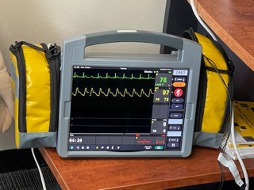Medical Emergencies in the Dental Practice 2024 – Part 1
Every year we spend a Friday morning 9am-2pm learning of the change in handling a medical emergency in a dental practice. Remember, a dental practice starts from the front door, into the waiting room, down the hallway, though to the surgery and into the chair. Let’s not forget the sterilising room, storeroom, tea room and, of course, the toilet.
This year we saw how technology is advancing. There are defibrillators with display that will show how hard the chest compressions are being applied as well as the electrical activity of the heart beat and pulse.

Now this year the medical emergency is in the waiting room.

Danger – this is along the lines – “you can’t help someone if you can’t help yourself”- make sure you the first aider is not in danger. In a dental situation this could be nearby sharp dental instruments, a slippery floor, or tripping hazards.
Response – check the patient response to stimuli in a progressive manner, starting with your voice, then a gentle tap to the cheek (this stimulates the cranial nerves), then a pin in the soft underpart of the upper arm. If no response then…
Send– for help. In our surgery we have a red bag that contains our medical emergency kit, so we would call out “Red Bag, Red Bag, Red Bag!” The other staff would respond that they have heard “Red Bag, Red Bag, Red Bag!” This sets off people to perform necessary tasks – Carry the Red Bag to the area of the emergency; Call the ambulance and if enough staff – document the event.
Why Red Bag? This not a normal terminology we would use in our day to day work. To say this is a big deal, rather than “need help”.
Airway – Ensure the airway is clear by tilting the head back and moving the lower jaw forward. This allows direct vision of the airway. Remove any contents such as food vomit saliva.
If the patient is in the surgery, use suction, or a dental mirror to remove the contents.

If not in the surgery, then roll them on to the side so that the contents can come out of the mouth.

Breathing – for an adult one hand on the diaphragm area on the chest, which is the end of the sternum, just below the rib cage, and the other hand, to keep the head tilted back. Feel for the movement of the diaphragm of the lungs and listen for breathes at the mouth.
Check for 10 seconds. We need to have 2 breathes!
It must be a breathe IN and OUT.
If not breathing then we assume a cardiac arrest-start compressions!!!!
We are now at the CD of the DRSABCD.
Compression – Get as close as you can to the patient as possible and place the palms of the hand on top of each other on the mid sternum (in between the nipples) and compress and depress firmly at 2 compressions every second. Yes it’s hard and fast i.e. 120 compressions per minute.
When working in a team count the compression and swap every 15 compressions. Use your body weight to maintain a rhythm. It is very tiring! Don’t stop and keeping going till the paramedics take over or the person becomes conscious.
Defibrillation – at Seymour Dental we have a defibrillator. If there is enough staff, the defibrillator is brought in and operated by people other than the team doing the compressions.
Clothing and bras will need to removed or cut off with scissors, and if necessary, thick body hair removed with a shaver. If hair is not removed where the pads go and a shock is delivered, the heat will burn the hair!
Right pad goes under right collar bone, above the right nipple.
Left pad goes under the left nipple around upper side of the body that is under the arm.
The Defibrillator now is able to assess the electrical activity of the heart. The machine will call out instructions. It will say “stop compressions, analysing”. It is determining if the heart rhythm is shockable. (25% of cardiac arrests are non-shockable rhythms).
Everyone keeps clear of the entire body.
Next it will say either:
- Continue compressions; or
- Keep clear, deliver shock, analysing
Compressions continue and the machine will analyse every two minutes automatically.


Need an Appointment?
If you’d like to book an appointment with the dentist at Seymour Dental then call us in Dulwich Hill, Sydney on (02) 9564 2397 or
contact us
Next week
Medical Emergencies in the Dental Practice 2024 - Part 2